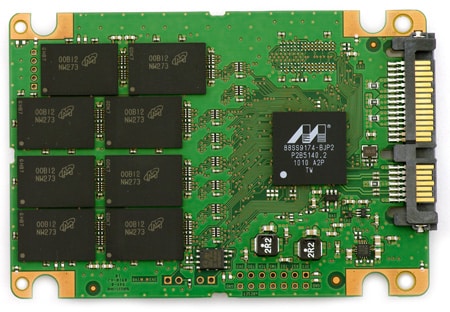To avoid any concerns over 25nm NAND, several SSD manufacturers are trying to get out ahead of their impending SSD releases with consumer updates on their implementation of 25nm NAND. Micron has updated us with details surrounding their new SATA 6Gb/s C400 SSD, and the consumer equivalent Crucial m4 SSD.
Micron and Crucial will be marketing drives as the true user supported capacity. The C400 and Crucial m4 SSDs are going to be available in the following capacities: 64 GB, 128GB, 256GB and 512GB. Micron says they can deliver the expected performance and endurance without the need for over-provisioning, which in effect decreases the user available capacity of the SSDs.
C300 PCB
In terms of performance Micron broke a lot of records, and new ground, with the C300. The C400 builds on these achievements and delivers a projected 17% step up in performance, with up to 415MB/s writes and 260MB/s writes (512GB C400). Not bad, considering we’ve seen only modest speed changes on most 25nm NAND SSD spec sheets. Micron has an advantage though since they use their own NAND and probably have a deeper understanding of NAND than any other SSD manufacturer; Intel, Samsung and Toshiba excluded.
Endurance is the other issue consumers fear when talking about 25nm NAND. 34nm NAND is generally rated for 5,000 write cycles, which turns out is about five times what consumers needed out of SSDs. 25nm NAND hits around 3,000 write cycles, which still exceeds average usage, even if it is less than before. But write cycles themselves don’t translate very well – buyers need a better metric to understand the longevity of their SSD. To that end, Micron and some other manufacturers are starting to move toward better transparency by disclosing drive endurance in terms of total bytes written (TBW). Intel has talked about TBW for their SSDs for a while and last year Western Digital joined the party by listing the amount of data a user could write to the SiliconEdge SSD. Even so there are fewer than a handful of SSD manufacturers participating by sharing this endurance data.
Back to Micron though, for the 128GB, 256GB and 512GB capacities the endurance specification of the C400 is 72 terabytes TBW (same as the C300). Over the expected 5 year life of an SSD, that means a user could write 40GB of data to the drive every day, which unless you like to re-download your games from Steam every time you play them, is a number unlikely to be attained by any but the most extremely active users. The value-oriented C400v 64GB posts an endurance spec of 36 terabytes TBW, which covers users for 20GB of writes every day for 5 years.
While this week has been turbulent (to say the least) for SSD manufacturers, there’s actually been a great benefit to the consumer. Companies are being more transparent, which is great. The more we know about the products we’re buying, the better. To Micron specifically, a tip of the hat for going the extra step and disclosing endurance data, something that can rarely be found on an SSD spec sheet.
We all want to know how the C400 and m4 benchmark though – we’ll be back soon with a detailed review.
Update 5/12/2011 – Crucial m4 Review Posted





 Amazon
Amazon